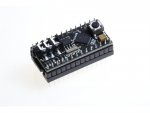Is there any data regarding the accuracy and stability relative to temperature (or otherwise) of the resonator/crystal fitted to the AXE201 (28X2) module?
I ask as I'm trying to read frequency with an accuracy well into in the mHz range. I understand that the internal resonator in the M2 series is close to 1% but with a 50Hz input, 1%=500mHz which is rather a long way from the +/- 5mHz accuracy I'm aiming for. As I can use #SetFreq to shift the M2 resonator in what is suggested to be 0.1% steps (still 50mHz though) I wondered if it would be possible to use a 28X2 on an AXE201 module as a reference and calibrate the M2 devices from that.
Needless to say, while I have a frequency counter, I don't have anything that comes close to the +/- 5mHz degree of accuracy I'd like. The best I've got gives a reading of +/- 250mHz and little about accuracy.
On a similar line... Is there a command that controls the multiplication of the PLL within the 28X2? Using #SetFreq EM32 (EM16 or EM64) seems to have no effect on the values returned by PulsIn?
I ask as I'm trying to read frequency with an accuracy well into in the mHz range. I understand that the internal resonator in the M2 series is close to 1% but with a 50Hz input, 1%=500mHz which is rather a long way from the +/- 5mHz accuracy I'm aiming for. As I can use #SetFreq to shift the M2 resonator in what is suggested to be 0.1% steps (still 50mHz though) I wondered if it would be possible to use a 28X2 on an AXE201 module as a reference and calibrate the M2 devices from that.
Needless to say, while I have a frequency counter, I don't have anything that comes close to the +/- 5mHz degree of accuracy I'd like. The best I've got gives a reading of +/- 250mHz and little about accuracy.
On a similar line... Is there a command that controls the multiplication of the PLL within the 28X2? Using #SetFreq EM32 (EM16 or EM64) seems to have no effect on the values returned by PulsIn?

